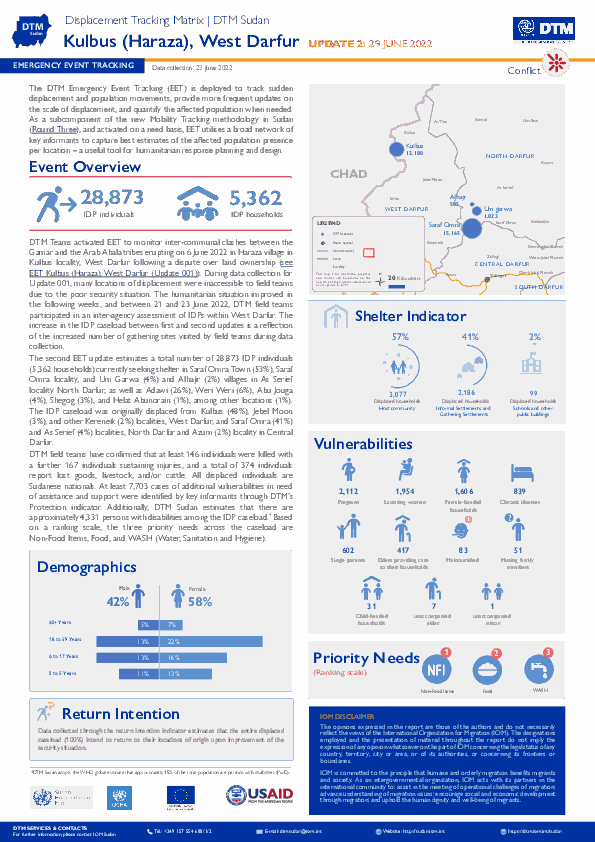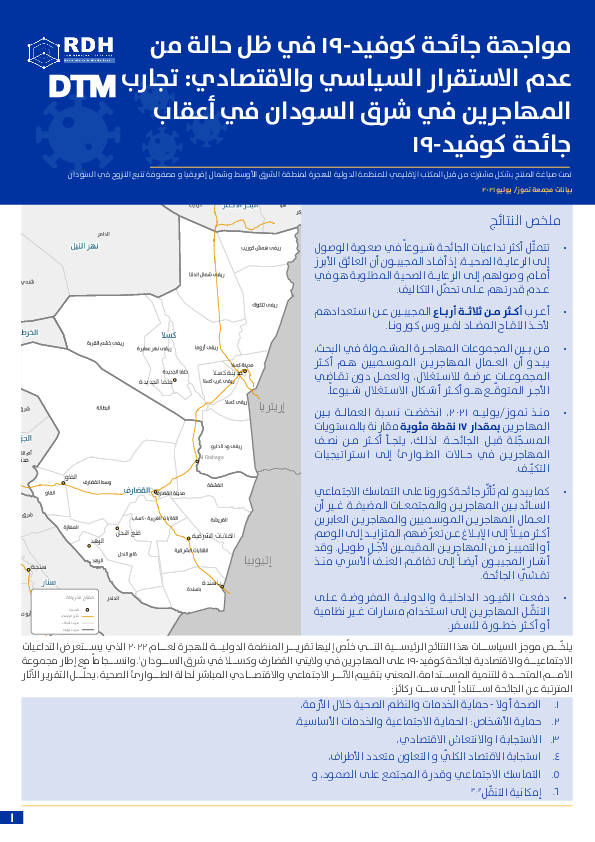-
Countries
-
Data and Analysis
-
Special Focus
-
Crisis Responses
Contact
DTMUkraine@iom.int
Location
Ukraine
Activity
- Mobility Tracking
- Baseline Assessment
Period Covered
Jun 13 2022 -Jun 26 2022
A baseline assessment is a sub-component of mobility tracking. It aims to collect data on IDP, migrant or returnee population presence in a defined administrative area of the country.
Population Groups
Survey Methodology
Unit of Analysis Or Observation
Type of Survey or Assessment
Keywords
Geographical Scope
Administrative boundaries with available data
The current dataset covers the following administrative boundaries
Contact
DTMUkraine@iom.int
Location
Ukraine
Activity
- Mobility Tracking
- Baseline Assessment
Period Covered
Jun 14 2022 -Jun 26 2022
A baseline assessment is a sub-component of mobility tracking. It aims to collect data on IDP, migrant or returnee population presence in a defined administrative area of the country.
This is a restricted dataset. To get access, kindly click on the 'Request Access' button.
Population Groups
IDPs
Survey Methodology
Unit of Analysis Or Observation
Admin Area 2
Type of Survey or Assessment
Key Informant
Keywords
Geographical Scope Partial Coverage
Administrative boundaries with available data
The current dataset covers the following administrative boundaries

Contact
DTM Nigeria, AllUsersInDTMNigeria@iom.int
Language
English
Location
Nigeria
Period Covered
Jun 20 2022
Jun 26 2022
Activity
- Mobility Tracking
- Event Tracking
The DTM Emergency Tracking Tool (ETT) is deployed to track and to collect information on large and sudden population movements, provide frequent updates on the scale of displacement and quantify the affected population when needed. As a sub-component of the Mobility Tracking methodology in Nigeria, ETT utilises direct observation and a broad network of key informants to capture best estimates of the affected population per location, enabling targeted humanitarian response planning.
Between 20 and 26 June 2022, a total of 3,709 new arrivals were recorded in Adamawa and Borno States. The new arrivals were recorded at locations in Askira/Uba, Bama, Damboa, Gwoza, Kala Balge, Monguno and Ngala Local Government Areas (LGAs) of the most conflict-affected state of Borno and in Demsa, Fufore, Girei, Gombi, Guyuk, Hong, Lamurde, Maiha, Michika, Mubi South, Numan, Song, Yola North and Yola South LGAs of Adamawa State.
ETT assessments identified the following movement triggers: improved security (1,611 individuals or 43%), military operations (792 individuals or 21%), poor living conditions (735 individuals or 20%), family re-unification (173 individuals or 5%), seasonal farming (165 individuals or 4%), lack of humanitarian assistance (110 individuals or 3%), fear of attacks (98 individuals or 3%), and communal clashes (25 individuals or 1%).

Contact
DTM Nigeria, AllUsersInDTMNigeria@iom.int
Language
English
Location
Nigeria
Period Covered
Apr 01 2022
Apr 30 2022
Activity
- Flow Monitoring
IOM, through the Displacement Tracking Matrix (DTM) Flow Monitoring tool, collects data at key entry, exit and transit points to better understand population movements across West and Central Africa. The monitoring of population flows allows for the quantification and qualification mobility flows and trends, migrant profiles, and migratory experiences and routes. Since March 2017 two Flow Monitoring Points (FMPs) have been active in Kano and Sokoto in northern Nigeria, monitoring mobility within the country and between Nigeria, Niger and beyond.
In Nigeria, DTM conducts Flow Monitoring activities in several important transit locations in Sokoto and Kano to monitor the movements of passenger buses to and from Niger. The Sokoto FMP covers three migratory routes in Illela, Gada and Sabon-Birnin. And the Kano FMP (Kofar Ruwa Park and Yankaba Park) covers two migratory routes in Dala and Nasarawa Local Government Areas in Kano state.
This report presents data collected on flows, routes, provenance, destination and demographic profiles of travellers observed at the FMPs between 1 and 30 April 2022.

Contact
DTM Europe, DTMMediterranean@iom.int
Language
English
Location
Slovakia
Period Covered
May 23 2022
Jun 24 2022
Activity
- Flow Monitoring
Since 24 February 2022, an increasing number of persons fleeing from Ukraine to the neighbouring countries has been observed, as a result of the war in Ukraine.
This report is based on cumulative and daily registrations by the Bureau of Border and Foreign Police of the Presidium of the Police Force (BBFP) of Ukrainian refugees and third-country nationals (TCNs) entering from Ukraine to the territory of Slovakia through all Border Crossing Points (BCPs), since 24 February 2022, numbers of those who exited the country towards Ukraine, as well as on number of those who applied for asylum or temporary protection in Slovakia.
To date, Ukrainian refugees represent 92 per cent (501,059) of all individuals registered at entry from Ukraine to Slovakia, with 6 per cent (30,845) of Third-Country Nationals (TCNs) and 2 per cent (9,822) of Slovak nationals recorded.
The Horn of Africa and Yemen is one of the busiest and riskiest migration corridors in the world travelled by hundreds of thousands of migrants, the majority of whom travel in an irregular manner, often relying on smugglers to facilitate movement along the Eastern Route. This regional report provides monthly updates on the complex migratory dynamics through Djibouti, Somalia, Yemen and Ethiopia based on diverse data sources and consultations with key informants in the four countries. Moreover, it provides information on the main protection concerns for migrants along the journey, information on the spill over effects of the conflict in Northern Ethiopia observed at the border between Ethiopia, Kenya and Sudan, a specific focus on children and information on the returns from Saudi Arabia to Ethiopia, Somalia and Yemen.

Contact
DTM Sudan; dtmsudan@iom.int
Language
English
Location
Sudan
Snapshot Date
Jun 23 2022
Activity
- Mobility Tracking
- Event Tracking
The DTM Emergency Event Tracking (EET) is deployed to track sudden displacement and population movements, provide more frequent updates on the scale of displacement, and quantify the affected population when needed. As a subcomponent of the new Mobility Tracking methodology in Sudan (Round Three), and activated on a need basis, EET utilises a broad network of key informants to capture best estimates of the affected population presence per location – a useful tool for humanitarian response planning and design.

Contact
DTM Sudan, DTMSudan@iom.int
Language
Arabic
Location
Sudan
Period Covered
Jun 01 2021
Jul 31 2022
Activity
- Other
- Community Perception
يلخـــص موجز السياســـات هذا النتائج الرئيســـية التـــي خلُص إليها تقريـــر المنظمة الدوليـــة للهجرة لعـــام 2022 الذي يســـتعرض التداعيات الإجتماعية و الأقتصادية لجائحة كوفيد-19 علي المهاجرين في ولايتيالقضارف و كسلا في شرق السودان. وانســـجاماً مع إطار مجموعة الأمم المتحدة للتنمية المستدامة، المعني بتقييم الأثر الإجتناعي و الإقتصادي المباشر لحالة الطوارئ الصحية، يحلّـــل التقرير الآثار المترتبة عن الجائحة اســـتناداً إلي ستة ركائز:
1- الصحة اولاً - حامية الخدمات والنظم الصحية خلال الأزمة،
2- حامية الأشخاص: الحامية الأجتماعية والخدمات الأساسية،
3- الأستجابة و الأنتعاش الأقتصادي،
4- استجابة الأقتصاد الكلّي و التعاون متعدد الأطراف،
5- التماسك الأجتماعي و قدرة المجتمع علي الصمود، و
6- إمكانيو التنقٌل.

Contact
DTM Nigeria, AllUsersInDTMNigeria@iom.int
Language
English
Location
Nigeria
Period Covered
Jun 20 2022
Jun 26 2022
Activity
- Mobility Tracking
- Event Tracking
Nigeria's north-central and north-west zones are afflicted with a multi-dimensional crisis rooted in long-standing tensions between ethnic and religious groups and involves attacks by criminal groups and banditry/hirabah (such as kidnapping and grand larceny along major highways). During the past years, the crisis has accelerated because of the intensification of attacks and has resulted in widespread displacement across the region.
Between the 20th and 26th of June 2022, armed attacks, rainstorms and communal clashes have led to new situations of forced displacement in the states of Benue, Kaduna, Sokoto and Zamfara. Following these events, a rapid assessment was conducted by DTM (Displacement Tracking Matrix) field staff to inform the humanitarian community and government partners, and enable targeted response. Flash reports utilise direct observation and a broad network of key informants to gather representative data and collect information on the number, profile and immediate needs of affected populations.
During the assessment period, the DTM identified an estimated 8,672 individuals who were affected by the attacks, 196 individuals by rainstorms and 120 individuals by communal clashes. A total of 8,593 individuals were displaced to neighbouring wards in Okpokwu LGA of Benue state, Kachia LGA of Kaduna state, Tureta LGA of Sokoto state, and Maradun and Gusau LGAs of Zamfara State as a result of the attack. Communal clashes in Langtang north LGA of Plateau State displaced about 119 individuals from their places of residence and 196 individuals were displaced by rainstorms in Kebbe LGA of Sokoto state to neighbouring shelters in the community. A total of 218 casualties were reported, including 138 injuries and 80 fatalities.
The lingering conflict in Nigeria's North East Zone has been the major cause of widespread population displacement. Over 2 million persons have been forced to leave their areas of residence in search of safety and security in neighbouring wards and LGAs.
On 20 June 2022, a Non-State Armed Group (NSAG) carried out an attack in Madagali ward in Madagali LGA of Adamawa State, leading to a wave of population displacement. Following the attack, a rapid assessment was conducted by DTM field staff with the purpose of informing the humanitarian community and government partners, and enabling targeted response. Flash reports utilise direct observation and a broad network of key informants to gather representative data and collect information on the number, profile and immediate needs of the affected population.
As a result of the attack, a total of 665 individuals from 133 households were displaced from their communities in Madagali ward to neighbouring localities within the same ward. The majority of those affected are refugees who are initially displaced from Cameroon. The displaced population is currently residing with residents in the host community and are in need of shelter, NFIs and food.

